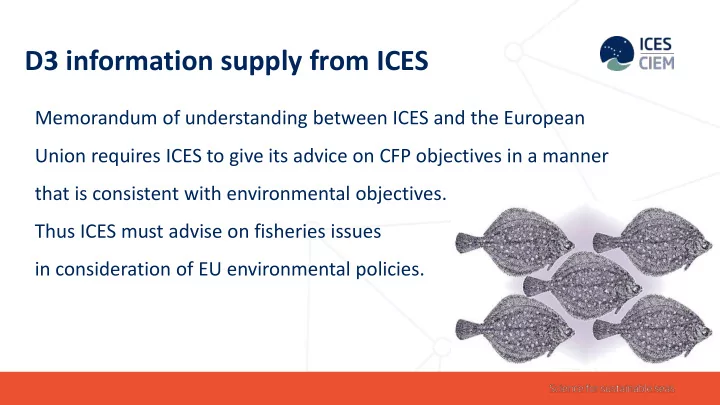

D3 information supply from ICES Memorandum of understanding between ICES and the European Union requires ICES to give its advice on CFP objectives in a manner that is consistent with environmental objectives. Thus ICES must advise on fisheries issues in consideration of EU environmental policies.
D3 information supply by 2017 • GES by stock D3C1 & D3C2 integrated per stock • GES by region proportion of stocks D3C1 & D3C2 & missing data • D3 summary sheet for each ICES ecoregion Not cover ICCAT, non-TAC, coastal Baltic
Regional Assessment Information base EEA
Regional Assessment In relation to GES EEA
Baltic Sea • 1 Brill (Scophthalmus rhombus) Stocks covered • 2 Cod (Gadus morhua) • 1 Dab (Limanda limanda) • 4 Flounder (Platichtys flesus) • 5 Herring (Clupea harengus) • 2 Plaice (Pleuronectes platessa) • 2 Salmon (Salmo salar) • 2 Sole (Solea solea) • 1 Sprat (Sprattus sprattus) • 1 Sea trout (Salmo trutta) • 1 Turbot (Scophthalmus maximus) • 1 Skates and rays • European eel (Anguilla anguilla)
Details, for information.... You can’t read it on a screen • Brill (Scophthalmus rhombus) in Subdivisions 22 – 32 (Baltic Sea) • Cod (Gadus morhua) in Subdivisions 22 – 24 (Western Baltic Sea) • Cod (Gadus morhua) in Subdivisions 25 – 32 (Eastern Baltic Sea) • Dab (Limanda limanda) in Subdivisions 22 – 32 (Baltic Sea) • Flounder (Platichtys flesus) in Subdivisions 22 and 23 (Belt Sea and Sound) • Flounder (Platichtys flesus) in Subdivisions 24 and 25 (West of Bornholm, Southern Central Baltic - West) • Flounder (Platichtys flesus) in Subdivisions 26 and 28 (East of Gotland, Gulf of Gdansk) • Flounder (Platichtys flesus) in Subdivisions 27 and 29-32 (Northern Central and Northern Baltic Sea) • Herring (Clupea harengus) in Subdivisions 25 – 29 and 32 (Central Baltic Sea, excluding Gulf of Riga) • Herring (Clupea harengus) in Subdivision 30 (Bothnian Sea) • Herring (Clupea harengus) in Subdivision 31 (Bothnian Bay) • Herring (Clupea harengus) in Division IIIa and Subdivisions 22 – 24 (spring spawners) (Skagerrak and Kattegat, Western Baltic) • Herring (Clupea harengus) in Subdivision 28.1 (Gulf of Riga) • Plaice (Pleuronectes platessa) in Subdivisions 21-23 (Kattegat, Belt Sea, Sound) • Plaice (Pleuronectes platessa) in Subdivisions 24-32 (Baltic Sea excluding Sound and Belt Sea) • Salmon (Salmo salar) in Subdivisions 22 – 31 (Baltic Sea, excluding Gulf of Finland) • Salmon (Salmo salar) in Subdivision 32 (Gulf of Finland) • Sole (Solea solea) in Division IIIa and Subdivisions 22 – 24 (Skagerrak and Kattegat, Western Baltic Sea) • Sprat (Sprattus sprattus) in Subdivisions 22 – 32 (Baltic Sea) • Sea trout (Salmo trutta) in Subdivisions 22 – 32 (Baltic Sea) • Turbot (Scophthalmus maximus) in Subdivisions 22 – 32 (Baltic Sea) • Other skates and rays in Subarea VIII and Division IXa (Bay of Biscay and Atlantic Iberian Waters) • European eel (Anguilla anguilla) throughout its natural range
Overview of approaches
Upcoming ICES advice D3C3 ICES evaluated the proposed indicators for D3C3 • the size distribution of the stock, • the selectivity pattern of the fishery • the genetic effects of the exploitation on the stock Concluded that the indicators were currently neither operational nor fit for purpose for the assessment of GES. Consequently, ICES advises that these indicators should not be used until usable reference points have been developed. ICES recommends that the assessment of GES for descriptor D3 should focus on indicators for Criteria D3C1 and D3C2.
Upcoming advice D3 assessment ICES advises that the GES assessment based on criteria D3C1 (level of pressure of fishing activity) and D3C2 (reproductive capacity of the stock) until further D3C3 development has taken place. The assessment should be based only on those stocks that have primary indicators (MSY reference points). ICES advises that there is no agreed approach for using secondary indicators to assess GES. ICES therefore advises that assessment of GES should be based only on those stocks that have primary indicators until an approach for secondary indicators has been agreed.
Upcoming advice D3 assessment Stock approach – aggregation of D3C1 and D3C2 by conditional method, both criteria must be met for GES by stock Regional assessment – aggregation by criteria across region, with a proportional approach. Agreed limits for each of these criteria to define GES is outside the ICES remit and should be decided at the policy level. ICES advises that “commercial fish and shellfish” relevant for assessing GES are those stocks considered important to any Member State and on national lists under the EU’s Data Collection Framework; the total landings of these stocks should be a very high proportion of the landings (e.g. >90%) in weight by that Member State.
Challenges By sub region? i.e. space and layers Data on recreational fisheries D3C4- database on the way at ICES Reconciling timings
Recommend
More recommend